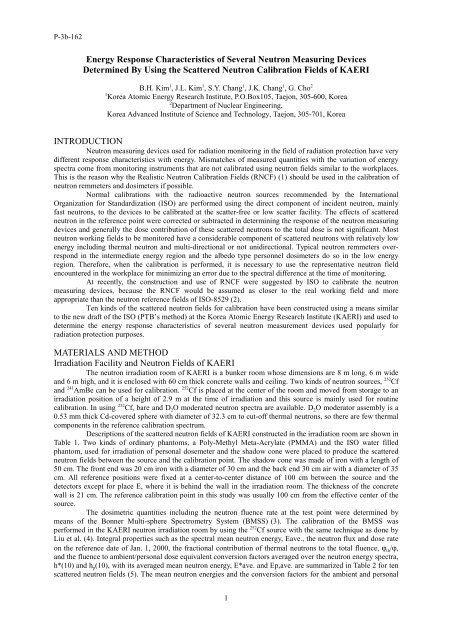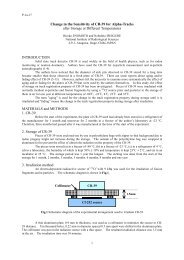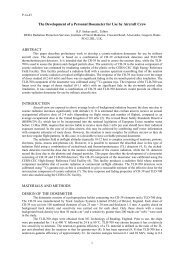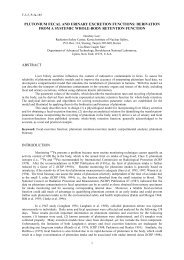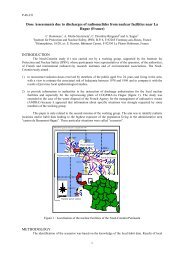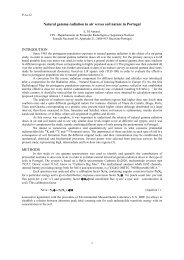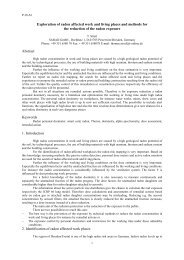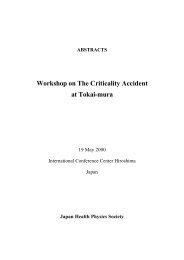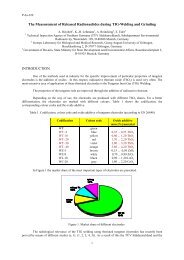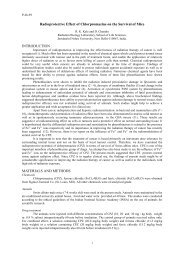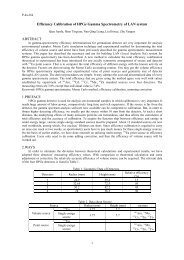Energy Response Characteristics of Several Neutron Measuring ...
Energy Response Characteristics of Several Neutron Measuring ...
Energy Response Characteristics of Several Neutron Measuring ...
Create successful ePaper yourself
Turn your PDF publications into a flip-book with our unique Google optimized e-Paper software.
P-3b-162<br />
<strong>Energy</strong> <strong>Response</strong> <strong>Characteristics</strong> <strong>of</strong> <strong>Several</strong> <strong>Neutron</strong> <strong>Measuring</strong> Devices<br />
Determined By Using the Scattered <strong>Neutron</strong> Calibration Fields <strong>of</strong> KAERI<br />
B.H. Kim 1 , J.L. Kim 1 , S.Y. Chang 1 , J.K. Chang 1 , G. Cho 2<br />
1 Korea Atomic <strong>Energy</strong> Research Institute, P.O.Box105, Taejon, 305-600, Korea<br />
2 Department <strong>of</strong> Nuclear Engineering,<br />
Korea Advanced Institute <strong>of</strong> Science and Technology, Taejon, 305-701, Korea<br />
INTRODUCTION<br />
<strong>Neutron</strong> measuring devices used for radiation monitoring in the field <strong>of</strong> radiation protection have very<br />
different response characteristics with energy. Mismatches <strong>of</strong> measured quantities with the variation <strong>of</strong> energy<br />
spectra come from monitoring instruments that are not calibrated using neutron fields similar to the workplaces.<br />
This is the reason why the Realistic <strong>Neutron</strong> Calibration Fields (RNCF) (1) should be used in the calibration <strong>of</strong><br />
neutron remmeters and dosimeters if possible.<br />
Normal calibrations with the radioactive neutron sources recommended by the International<br />
Organization for Standardization (ISO) are performed using the direct component <strong>of</strong> incident neutron, mainly<br />
fast neutrons, to the devices to be calibrated at the scatter-free or low scatter facility. The effects <strong>of</strong> scattered<br />
neutron in the reference point were corrected or subtracted in determining the response <strong>of</strong> the neutron measuring<br />
devices and generally the dose contribution <strong>of</strong> these scattered neutrons to the total dose is not significant. Most<br />
neutron working fields to be monitored have a considerable component <strong>of</strong> scattered neutrons with relatively low<br />
energy including thermal neutron and multi-directional or not unidirectional. Typical neutron remmeters overrespond<br />
in the intermediate energy region and the albedo type personnel dosimeters do so in the low energy<br />
region. Therefore, when the calibration is performed, it is necessary to use the representative neutron field<br />
encountered in the workplace for minimizing an error due to the spectral difference at the time <strong>of</strong> monitoring.<br />
At recently, the construction and use <strong>of</strong> RNCF were suggested by ISO to calibrate the neutron<br />
measuring devices, because the RNCF would be assumed as closer to the real working field and more<br />
appropriate than the neutron reference fields <strong>of</strong> ISO-8529 (2).<br />
Ten kinds <strong>of</strong> the scattered neutron fields for calibration have been constructed using a means similar<br />
to the new draft <strong>of</strong> the ISO (PTB’s method) at the Korea Atomic <strong>Energy</strong> Research Institute (KAERI) and used to<br />
determine the energy response characteristics <strong>of</strong> several neutron measurement devices used popularly for<br />
radiation protection purposes.<br />
MATERIALS AND METHOD<br />
Irradiation Facility and <strong>Neutron</strong> Fields <strong>of</strong> KAERI<br />
The neutron irradiation room <strong>of</strong> KAERI is a bunker room whose dimensions are 8 m long, 6 m wide<br />
and 6 m high, and it is enclosed with 60 cm thick concrete walls and ceiling. Two kinds <strong>of</strong> neutron sources, 252 Cf<br />
and 241 AmBe can be used for calibration. 252 Cf is placed at the center <strong>of</strong> the room and moved from storage to an<br />
irradiation position <strong>of</strong> a height <strong>of</strong> 2.9 m at the time <strong>of</strong> irradiation and this source is mainly used for routine<br />
calibration. In using 252 Cf, bare and D 2 O moderated neutron spectra are available. D 2 O moderator assembly is a<br />
0.53 mm thick Cd-covered sphere with diameter <strong>of</strong> 32.3 cm to cut-<strong>of</strong>f thermal neutrons, so there are few thermal<br />
components in the reference calibration spectrum.<br />
Descriptions <strong>of</strong> the scattered neutron fields <strong>of</strong> KAERI constructed in the irradiation room are shown in<br />
Table 1. Two kinds <strong>of</strong> ordinary phantoms, a Poly-Methyl Meta-Acrylate (PMMA) and the ISO water filled<br />
phantom, used for irradiation <strong>of</strong> personal dosemeter and the shadow cone were placed to produce the scattered<br />
neutron fields between the source and the calibration point. The shadow cone was made <strong>of</strong> iron with a length <strong>of</strong><br />
50 cm. The front end was 20 cm iron with a diameter <strong>of</strong> 30 cm and the back end 30 cm air with a diameter <strong>of</strong> 35<br />
cm. All reference positions were fixed at a center-to-center distance <strong>of</strong> 100 cm between the source and the<br />
detectors except for place E, where it is behind the wall in the irradiation room. The thickness <strong>of</strong> the concrete<br />
wall is 21 cm. The reference calibration point in this study was usually 100 cm from the effective center <strong>of</strong> the<br />
source.<br />
The dosimetric quantities including the neutron fluence rate at the test point were determined by<br />
means <strong>of</strong> the Bonner Multi-sphere Spectrometry System (BMSS) (3). The calibration <strong>of</strong> the BMSS was<br />
performed in the KAERI neutron irradiation room by using the 252 Cf source with the same technique as done by<br />
Liu et al. (4). Integral properties such as the spectral mean neutron energy, Eave., the neutron flux and dose rate<br />
on the reference date <strong>of</strong> Jan. 1, 2000, the fractional contribution <strong>of</strong> thermal neutrons to the total fluence, ϕ th /ϕ,<br />
and the fluence to ambient/personal dose equivalent conversion factors averaged over the neutron energy spectra,<br />
h*(10) and h p (10), with its averaged mean neutron energy, E*ave. and Ep,ave. are summarized in Table 2 for ten<br />
scattered neutron fields (5). The mean neutron energies and the conversion factors for the ambient and personal<br />
1
P-3b-162<br />
dose equivalents were calculated using the values obtained from the interpolation method <strong>of</strong> cubic spline for the<br />
conversion factors for mono-energetic neutrons given by ICRP 74 (6).<br />
Table 1. Description <strong>of</strong> KAERI scattered neutron fields.<br />
Notation<br />
Description<br />
252 Cf<br />
(bare)<br />
252 Cf<br />
(D 2 O)<br />
[A]<br />
[B]<br />
[C]<br />
[D]<br />
[E]<br />
[F]<br />
[G]<br />
[H]<br />
[I]<br />
Direct and scattered; unmoderated source only<br />
Scattered; using the PMMA phantom (40 x 40 x 15 cm 3 , contacted to the source guide holder)<br />
Scattered; using the shadow cone (distance from the source to the front end : 32 cm)<br />
Scattered; using the PMMA phantom(same as B) and polyethylene sheet with 5% boron<br />
(61x 61 x 5 cm 3 , distance from the source to the surface : 40 cm)<br />
Behind the concrete wall in the irradiation room (distance from the source : 385 cm)<br />
Direct and scattered; moderated source only<br />
Scattered; using the PMMA phantom(same as B, distance from the source : 32 cm)<br />
Scattered; using the shadow cone (distance from the source to the front end : 32 cm)<br />
Scattered; using the water filled phantom (30 x 30 x 15 cm 3 , 32 cm from the source)<br />
241 AmBe [J] Direct and scattered; unmoderated source only<br />
Table 2. Integral properties <strong>of</strong> several scattered neutron fields in the neutron irradiation room <strong>of</strong> KAERI.<br />
Field<br />
Eave. a)<br />
(MeV)<br />
Flux<br />
(n.cm -2 sec -1 )<br />
ϕ th /ϕ<br />
(%)<br />
Dose rate b)<br />
(mSvhr -1 )<br />
h*(10)/ E*ave c)<br />
(pSvcm 2 /MeV)<br />
h p (10)/Ep,ave c)<br />
(pSvcm 2 /MeV)<br />
[A] 1.282 3019 10.2 3.557 327/1.63 339/1.64<br />
[B] 0.444 1449 51.2 0.673 129/1.42 133/1.42<br />
[C] 0.532 1260 24.8 0.940 207/1.03 214/1.03<br />
[D] 0.692 761 36.4 0.442 161/1.76 167/1.78<br />
[E] 0.282 323 53.1 0.109 93/1.20 96/1.22<br />
[F] 0.461 2734 9.4 1.095 111/1.46 115/1.47<br />
[G] 0.205 1009 48.6 0.261 69/1.18 72/1.19<br />
[H] 0.171 1060 38.9 0.348 91/0.70 94/0.70<br />
[I] 0.184 1028 44.9 0.279 75/0.95 78/0.98<br />
[J] 3.436 75 6.4 0.092 347/3.29 362/3.30<br />
a)<br />
spectral mean energy.<br />
b) ambient dose equivalent rate, H*(10).<br />
c)<br />
fluence to ambient (and personal) dose equivalent conversion factor and dose equivalent averaged mean<br />
energy reffered to the conversion factors given by ICRP-74 (6).<br />
Detector <strong>Response</strong><br />
<strong>Response</strong> characteristics <strong>of</strong> several neutron measurement devices were determined by getting the<br />
quotients <strong>of</strong> the detector indication by the dose equivalents given in table 2, which were determined by using the<br />
BMSS <strong>of</strong> KAERI. All neutron detectors were calibrated in the field <strong>of</strong> D 2 O moderated 252 Cf source and the<br />
indication values <strong>of</strong> the detector multiplied by the calibration factor. At the time <strong>of</strong> calibration, the effect <strong>of</strong><br />
scattered neutrons for each neutron detector was corrected by the semi-empirical fitting method <strong>of</strong> ISO (7). The<br />
six kinds <strong>of</strong> neutron detectors and their calibration factors are listed in Table 3.<br />
2
P-3b-162<br />
Table 3. <strong>Neutron</strong> detectors and calibration factors for D 2 O moderated 252 Cf.<br />
Detector model<br />
Detection method<br />
Calibration<br />
facor 1)<br />
NG-2 (NRC, USA) Cylindrical moderator and cylindrical BF 3 proportional counter 0.987<br />
ESP2/NRD (Eberline, USA) Spherical moderator and cylindrical BF 3 proportional counter 1.029<br />
Ludlum 12-4 (Ludlum, USA) Spherical moderator and spherical BF 3 proportional counter 0.917<br />
REM-500 (HPI, USA) Tissue equivalent proportional counter 0.968<br />
Dineutron (Nardeux, France) Two spherical 3 H proportional counter (2.5 & 4.2 inch) 0.794<br />
A300 (Teledyne, USA) Thermoluminescence dosimeter 0.979 2)<br />
1) Calibration factor for the D 2 O moderated 252 Cf.<br />
2) Dosimeters for calibration were irradiated on the ISO water-filled phantom at a distance <strong>of</strong> 50 cm using the same<br />
neutron source as 1) (8).<br />
RESULTS AND DISCUSSION<br />
Indications <strong>of</strong> all remmeters were lower than the quantities determined by BMSS , as a reference. This<br />
means that BMSS overestimates the dose equivalents for most neutron fields to be monitored and this trend <strong>of</strong><br />
BMSS is still reasonable in view <strong>of</strong> conservative radiation protection. When the calibration was performed in the<br />
field <strong>of</strong> D 2 O moderated 252 Cf, dose equivalents were over estimated from 20 % to 80 % roughly for the<br />
moderator type remmmeters in these measurements. These values can be reduced by the adoption <strong>of</strong> a calibration<br />
factor for a 252 Cf source. This is not common because the discrepancies between the reading values and the<br />
conventional true dose equivalents basically result from the big change in detector response with energy. Two<br />
ways to solve this problem were suggested by Naismith et al. (9): one is to use a similar neutron field to the<br />
workplace in the calibration <strong>of</strong> neutron detectors for use and the other is to apply the correction factors which are<br />
categorized for the specific neutron fields using the relations between the detector responses and some databased<br />
neutron fields.<br />
The responses and calibration factors were obtained for the ten kinds <strong>of</strong> neutron fields <strong>of</strong> KAERI and<br />
are given in Tables 4 and 5, and Figures 1 and 2. Even though these fields are not representative for the<br />
workplaces, the figures given in Tables 4 and 5 show that it is necessary to correct the response according to the<br />
neutron fields. In the case <strong>of</strong> TLD used in the field <strong>of</strong> the 252 Cf source only, [A], corrections more than four times<br />
should be applied to the readings if TLDs are conventionally calibrated in the field <strong>of</strong> D 2 O moderated 252 Cf. All<br />
moderator type remmeters have the similar response shape with energy and the calibration factors ranged from<br />
1.22 ~ 1.92, whereas REM-500 and Dineutron show different responses in the case <strong>of</strong> more scattered neutron<br />
fields or at low energy region. REM-500 has relatively low responses at low energies as shown in the paper by<br />
Thomas (10). In the case <strong>of</strong> Dineutron, special care is necessary to correct the low sensitivity when it is used in<br />
more scattered neutron fields for monitoring.<br />
Although it is not possible to determine the energy response by the definition without the use <strong>of</strong><br />
mono-energetic neutron sources, this paper shows what type <strong>of</strong> instruments are necessary to a specific neutron<br />
field and how important it is to correct the response <strong>of</strong> neutron detectors used in workplace monitoring.<br />
Table 4. <strong>Response</strong>s <strong>of</strong> neutron detectors in several scattered neutron fields.<br />
Field<br />
[A] [B] [C] [D] [E] [F] [G] [H] [I] [J]<br />
Detector<br />
NG-2 0.748 0.676 0.617 0.591 0.520 0.705 0.602 0.552 0.595 0.822<br />
ESP2/NRD 0.690 0.666 0.609 0.594 0.571 0.741 0.620 0.586 0.666 0.745<br />
Ludlunm 0.621 0.623 0.606 0.578 0.546 0.696537 0.646 0.648 0.687 0.616<br />
REM-500 0.605 0.584 0.557 0.526 0.463 0.466 0.354 0.348 0.362 0.786<br />
Dineutron 0.663 0.217 0.648 0.393 0.206 0.641 0.299 0.473 0.346 0.477<br />
A300(TLD) 0.189 0.968 - 1.885 0.679 0.828 1.256 - - -<br />
3
P-3b-162<br />
Table 5. Calibration factors <strong>of</strong> neutron detectors in the several scattered neutron fields.<br />
Field<br />
Detector<br />
[A] [B] [C] [D] [E] [F] [G] [H] [I] [J]<br />
NG-2 1.337 1.480 1.620 1.693 1.921 1.419 1.660 1.813 1.681 1.217<br />
+- 0.012 0.006 0.009 0.008 0.031 0.007 0.014 0.016 0.014 0.020<br />
ESP2/NRD 1.449 1.501 1.642 1.684 1.752 1.350 1.612 1.705 1.502 1.342<br />
+- 0.019 0.047 0.051 0.051 0.063 0.024 0.103 0.057 0.105 0.083<br />
Ludlum 1.611 1.605 1.651 1.732 1.832 1.436 1.548 1.543 1.456 1.622<br />
+- 0.007 0.026 0.027 0.048 0.099 0.015 0.073 0.044 0.049 0.121<br />
REM-500 1.652 1.712 1.795 1.900 2.159 2.146 2.823 2.877 2.765 1.272<br />
+- 0.108 0.212 0.185 0.221 0.714 0.192 0.848 0.454 0.314 0.210<br />
Dineutron 1.508 4.619 1.544 2.542 4.856 1.560 3.349 2.114 2.887 2.098<br />
+- 0.004 0.079 0.010 0.059 0.078 0.010 0.019 0.053 0.000 0.017<br />
A300(TLD) 5.270 1.034 - 0.531 1.473 1.208 0.796 - - -<br />
+- 0.843 0.051 - 0.025 0.076 0.034 0.032 - - -<br />
Fig. 1. <strong>Response</strong>s (up) and calibration factors (down) <strong>of</strong> remmeters for the scattered neutron fields.<br />
4
P-3b-162<br />
Fig. 2. <strong>Response</strong>s (left) and calibration factors (right) <strong>of</strong> TLD for the scattered neutron fields.<br />
ACKNOWLEDGEMENTS<br />
This study was the partial product <strong>of</strong> the national projects for long term nuclear energy development<br />
supported by the Ministry <strong>of</strong> Science and Technology.<br />
REFERENCES<br />
1. International Organization for Standardization (ISO), Reference <strong>Neutron</strong> Radiations: <strong>Characteristics</strong> and<br />
Methods <strong>of</strong> Production <strong>of</strong> Simulated Workplace <strong>Neutron</strong> Fields, International Standard ISO-12789, Draft<br />
(1997)<br />
2. International Organization for Standardization (ISO), <strong>Neutron</strong> Reference Radiations for Calibrating<br />
<strong>Neutron</strong> <strong>Measuring</strong> Devices used for Radiation Protection Purposes and for Determining their <strong>Response</strong><br />
As a Function <strong>of</strong> <strong>Neutron</strong> <strong>Energy</strong>, International Standard ISO-8529 (1989)<br />
3. R.L.Bramlett et al., A New Type <strong>of</strong> <strong>Neutron</strong> Spectrometer, Nuc. Inst. Meth., (9), 1-12 (1960)<br />
4. J.C. Liu, F. Hajnal, C.S. Sims and J. Kuiper, <strong>Neutron</strong> Spectral Measurements at ORNL, Radiat. Prot.<br />
Dosim.30(3), 169-178 (1990)<br />
5. B.H. Kim, J.L. Kim, S.Y. Chang and G. Cho, Scattered <strong>Neutron</strong> Calibration Fields <strong>of</strong> KAERI, J. Nucl.<br />
Sci.Technol. (in press)<br />
6. ICRP and ICRU, Conversion Coefficients for Use in Radiological Protection Against External Radiation,<br />
Report <strong>of</strong> the Joint Task Group, ICRP 74 (1997), ICRU 57 (1998)<br />
7. International Organization for Standardization (ISO), Reference <strong>Neutron</strong> Radiations : Dosimetry<br />
Fundamentala Related to the Basic Quantities Characterizing the Radiarion Field, International Standard<br />
ISO-8529-2, Draft (1995)<br />
8. S.Y. Chang, B.H. Kim and J.L. Kim, Intercomparison <strong>of</strong> <strong>Neutron</strong> Personnel Dosimeters in Korea, Radiat.<br />
Prot. Dosim. (in press)<br />
9. Naismith, B.R.L. Siebert and D.J. Thomas, <strong>Response</strong> <strong>of</strong> <strong>Neutron</strong> Dosemeters in Radiation Protection<br />
Environments: An Investigation <strong>of</strong> Techniques to improve Estimates <strong>of</strong> Dose Equivalent, Radiat. Prot.<br />
Dosim. 70(1-4), 255-260 (1997)<br />
10. D.J. Thomas and G.C. Taylor, <strong>Response</strong> Function Measurements for the REM 500: a Microdosimetric<br />
Counter Based Area Survey Instrument, Proceedings <strong>of</strong> Int’l Conf. on Radiat. Dosim. and Safety, Mar. 31-<br />
Apr. 2, Taipei, Taiwan, 285-289 (1997)<br />
5


